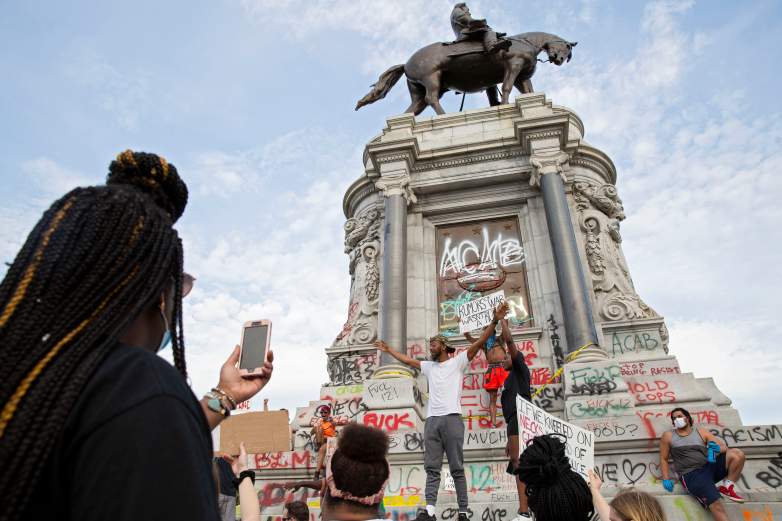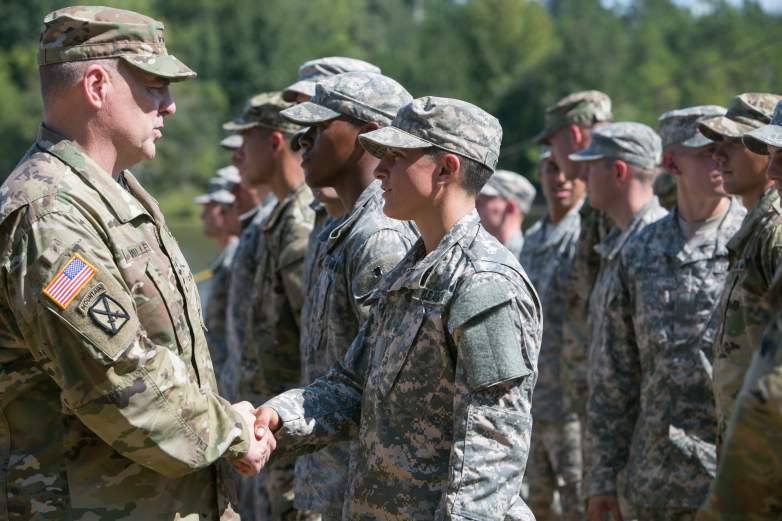
President Donald Trump has made it clear he won’t be renaming U.S. military bases named after Confederate generals.
On Wednesday, Trump took to Twitter to say that his administration refuses to entertain the idea, which has gained momentum in the wake of national protests over police brutality and racial injustices.
His remarks come just two days after Army Secretary Ryan McCarthy and Defense Secretary Mark Esper said they would be “open to a bipartisan discussion on the topic,” according to CNN.
In a series of tweets, the president expressed that the “powerful bases have become part of a great American heritage” and “history of winning, victory, and freedom,” therefore he won’t consider any name changes.
The Pentagon officials explained in a statement to CNN that the names “represent individuals, not causes or ideologies.” But recent uproar over the killing of George Floyd, an unarmed black man who died while in Minneapolis police custody, drove McCarthy to think differently, Politico reported.
The events of the past two weeks “made us start looking more at ourselves and the things that we do and how that is communicated to the force as well as the American public,” an official told the outlet.
Scores of anti-police protests erupted nationwide after harrowing footage emerged of Floyd’s arrest on May 25. Now-former Minneapolis police officer Derek Chauvin was filmed pressing his knee into the back of Floyd’s neck for over eight minutes as the 46-year-old begged for air.
Protesters have since demanded justice for Floyd, citing institutionalized racism in law enforcement agencies, as well as decades-worth of other victims.
Changing the Names Could be an Uphill Battle

GettyPeople gather around the Robert E. Lee statue on Monument Avenue in Richmond, Virginia, on June 4, 2020, amid continued protests over the death of George Floyd in police custody.
This isn’t the Army’s first run-in with accusations of upholding racism.
Prior to Floyd’s death, calls to change the names of the 10 installations were frequently dismissed by service officials — many arguing that it would upend the tradition of celebrating American soldiers.
A scathing editorial by the New York Times criticized the organization’s “apologist” way of thinking and accused it of “celebrating White supremacists.”
“The namings reflect a federal embrace of white supremacy that found its most poisonous expression in military installations where black servicemen were deliberately placed under the command of white Southerners,” the May 2020 post read.
In 2017, lawmakers called on the Army to rename two streets named after Robert E. Lee and Stonewall Jackson in Fort Hamilton, New York after violent clashes ensued in Charlottesville, Virginia over the removal of a statue of Lee.
The Army refused, saying that changing the names would be “controversial and divisive.”
These are the 10 U.S. Military Bases Named After Confederate Generals

GettyUS Army Chief of Staff Gen. Mark A. Milley (L) , shakes hands and congratulates Capt. Kristen Griest (R) during the graduation ceremony of the United States Army’s Ranger School at Fort Benning, Georgia.
Fort A.P. Hill – Ambrose Powell Hill Jr.
The Virginia facility was founded as a training ground during World War II. It is named after Confederate General Ambrose Powell Hill Jr, who was killed in 1865 during the Breakthrough at Petersburg battle a week before the Confederacy surrendered.
Camp Beauregard – P.G.T. Beauregard
Located in Louisiana, the World War I installation was created as a training space. It is named after Pierre Gustave Toutant-Beauregard, a Confederate general who commanded armies in the Western Theater, including the Battle of Shiloh in Tennessee and the Siege of Corinth in Northern Mississippi.
Fort Benning – Henry Benning
The Georgia installation was formed as a basic training ground during World War I. Confederate General Henry Benning, who was present at the battles of Antietam and Gettysburg, inspired the name.
According to the New Georgia Encyclopedia, Benning “was one of Georgia’s delegates to a convention of nine slaveholding states, held in Nashville, Tennessee, to determine the Southern course of action if slavery were banned in the western territories.”
Fort Bragg – Braxton Bragg
Located in North Carolina, the venue is the largest military installation in the world. The base was named after Braxton Bragg, an U.S. Army officer who served as a Confederate general during the Civil War
In 1863, Bragg achieved the most significant Confederate victory in the Western Theater at the Battle of Chickamauga, according to History.com.
Fort Gordon – John Brown Gordon
Another Georgia installation, the base founded as a training site in World War I. It is named after John Brown Gordon, a Confederate general who had no prior military training.
Despite his lack of experience, he was one of the most successful commanders in General Robert E. Lee’s history.
Fort Hood – John Bell Hood
Located in Texas, the venue was founded during World War II and used to test tanks. It was named after John Bell Hood, a Confederate military officer who was promoted to full general in 1864.
Hood was one of the most rapidly promoted leaders in the Confederate history of the Civil War, according to the American Battlefield Trust.
Fort Lee – Robert E. Lee
Located in Virginia, the installation was first established during the Civil War and named after Gen. Robert. E. Lee.
Dubbed one of the greatest military leaders in history, Lee led the South’s attempt at secession during the Civil War. He challenged Union forces during some of the war’s bloodiest battles, including Antietam and Gettysburg.
Fort Pickett – George Pickett
The Virginia site was founded during World War II and named after Confederate Gen. George Pickett.
The general is popularly known for “Pickett’s Charge” at the Battle of Gettysburg during the Civil War, in which he made the farthest breach into Union lines. The assault resulted in a great number of Confederate casualties, though, deeming it unsuccessful.
Fort Polk – Leonidas Polk
Located in Louisiana, the facility was founded as a training ground during World War II. It is named after Episcopal Diocese of Louisiana Bishop Leonidas Polk, who became a Confederate general as a result of his friendship with West Point classmate Jefferson Davis.
Fort Rucker – Edmund Rucker
Located in Alabama, the facility opened during World War II and was named after Col. Edmund Rucker — he later received general status.
In 1864, Rucker was captured during the Battle of Nashville. Gen. Nathan Bedford Forest, who later became the Ku Klux Klan’s first Grand Wizard, organized for his release the following year.
READ NEXT: Harry Rogers: Virginia KKK Leader Accused of Driving Into Protesters